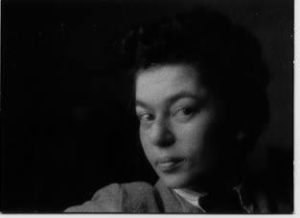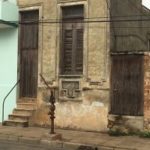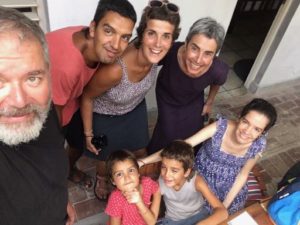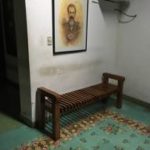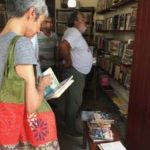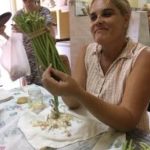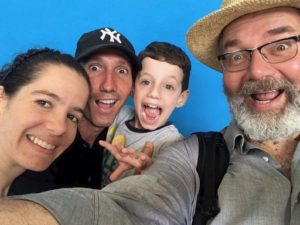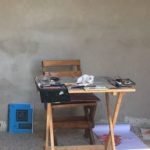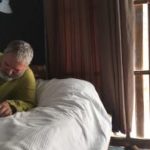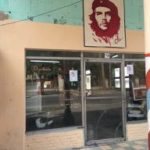I meet Michael Zank at his office, on the fourth floor of the Elie Wiesel Center. The first thing I notice is that it is full of books. No surprise there. The second thing I notice is a wind catcher that has the Israeli flag on one side and the Palestinian flag on the other side. “That is nothing.” Zank says. “My colleague Adam Seligman gave it to me, not sure why. But I like it.” These days Zank rarely gets to use this office and spends most afternoons at the director’s office downstairs. But since I was mostly interested in finding out how he had become a scholar of religion, we thought it was more appropriate to meet here.
“I’m an accidental religionist,” he says once we’ve settled down and I asked my question.
How did you get into religious studies?
The short answer is, I was hired into the BU Department of Religion at a time when the department tried to get a better handle on Jewish studies.
What was there before you were hired?
Don’t get me wrong! The department had a really interesting mix of faculty. But it wasn’t immediately clear to me how it all worked. Elie Wiesel was affiliated with the department and they had other really interesting people in religion and literature like Herbert Mason and Geoffrey Hill. But the real workhorses of the department were people like Merlin Swartz a classical Islamicist who unobtrusively trained a whole slew of distinguished Phds, Alan Olson who wrote on Heidegger and Jaspers and trained students in philosophy of religion, the rare Samaritologist James Purvis, and two outstanding women scholars, Paula Fredricksen and Livia Kohn. The chair at the time was Ray Hart, a philosopher of religion and former president of the American Academy of Religion. None of these colleagues who first hired me are there any longer, by the way.
So there was no one in Jewish studies?
There was, but it was haphazard. Director of Jewish studies Hillel Levine wasn't on speaking terms with the department. A former Israeli diplomat, Benno Varon, taught a course on Zionism. The intro to Judaism was taught by a local rabbi. The same year I was hired fresh out of graduate school, the department also hired two other young scholars: Ruth Langer who went on to teach at Boston College and Shaul Magid who went on to Rice University and now teaches in Bloomington/Indiana. John Silber also hired my dissertation advisor, Professor Marvin Fox, who was retiring from Brandeis University. He hoped that Fox would rebuild the Jewish studies program at BU and I believe he would have but he became ill and died of cancer shortly after he started at BU.
So you were left behind?
Right. But I was still only an adjunct. The lucky break came when someone told me about a job in Bristol/England. I applied and they offered me the position. I went to Ray Hart and said, unless you give me a real job I’ll be gone. Ray went to John Silber and said, “This is the guy we want,” and Silber gave me a tenure track position.
This sounds like you must have done something right?
Maybe. Mostly it was being at the right place at the right time. Ray also thought I was a quick learner. The first syllabus for the introduction to Judaism, a course I went on to teach every spring for the next eleven years, was way over the students’ heads. One of the students disarmingly told me they didn’t come to BU to study but to party.
Have students changed much since?
Absolutely. They still party, but they expect to work much harder than they did back then. This has disadvantages, too. In those days, back in the nineties and the early aughts, students were able to explore, discover, and change their minds. This made it exciting to work with them.
Are students less exciting today?
No. That’s not what I mean. Students are more worried today. More boxed in. But they’re still wonderful to work with. I wouldn’t miss it. I have the best job in the world.
What did you mean when you called yourself an accidental religionist?
I wasn’t trained in “religious studies.” My first degree is in Protestant Theology. My PhD is in Near Eastern and Judaic Studies, which is really just a name for the two departments at Brandeis that were merged to make them into a conglomerate of biblical and Jewish studies. I wrote my dissertation on Hermann Cohen, a modern German-Jewish philosopher. That also became my first book.
What is your favorite class?
Hands down: The Bible.
What kind of research do you do today?
Right now I am putting the finishing touches on a brief history of Jerusalem.
How can one write a “brief history” on such a big subject?
I worked on this for about ten years. The first draft was rejected because it was too long and it only covered half of the history. Maybe also because the publisher didn’t like the way it was written. I still think that it would have made a good book. I had to go back to the drawing board but the research I had done for the longer version helped.
Why write a history of Jerusalem if you’re more of a philosopher?
I love it. It’s a beautiful city. I have friends there. I worry about it a lot because it is such a deeply divided city. You need to write about what you love. Or perhaps also about what you hate. Sometimes those are the same.
Can you tell us a little about what’s special about the book you wrote?
What you are really asking is, why another book on such an old subject? What’s the hiddush, as they say in Hebrew? What are you adding to the vast stock of knowledge amassed on such a well-known subject?
Yes, that’s really what I am asking.
Here’s the thing. My father-in-law, Abe Shenitzer, who was a mathematician and a prolific editor and translator and who is one of the profoundest human beings I have known, used to have a lot of contempt for philosophers, and I am mostly a philosopher. There’s a joke that explains the difference between a mathematician and a philosopher. A mathematician needs three things to do his work: paper, pencil, and a waste basket. A philosopher only needs two of those.
Got it.
Abe also said that the thing about the humanities is that there’s always a different angle, so it doesn’t matter if you write on something others have already written about.
So what is your angle?
I am interested in the role of “scripture” (in the broadest sense, including different canons and schools of interpretation) in the politics of Jews, Christians, and Muslims. Jerusalem is a prime example, or rather a prism of Jewish, Christian and Muslim scriptural fantasies. These “religions” have produced what I like to call “biblicate” civilizations, ways of ordering the lives of communities that are rooted in, derived from, and sanctioned by scriptural precedent.
Do you mean the Evangelical fundamentalists and Muslim Salafists of today?
Yes, those too. But the really interesting thing, to me at least, is how the ways and means of appropriating these scriptures have changed from late antiquity to the middle ages and to the modern era. In contrast to what those of us believed who grew up in 1970’s Europe, religion hasn’t gone away but has returned with a vengeance. That’s a phenomenon we’ve not sufficiently understood. It took us by surprise.
And your book sheds light on this?
No. Not enough. But it is clear that the way religion was employed before the Protestant Reformation and after is very different. I regard the religious Zionism of the Israeli settler movement as a kind of “Protestant scripturalism” among the Jews. The same with Salafism, which is the ad fontes of Sunni Islam. We need to take a very sharp look at all the effects of the Reformation, not just the ones we like.
Are you turning Catholic?
Being a religionist, even an accidental one, means taking a hard look at religion. I like to say, that in contemporary America, the only place where religion is looked at not with respect but curiosity is the academic study of religion. Many of us believe that this subject should be taught in high schools as well.
Returning to religion at BU, how has the department changed since you joined?
The department has changed tremendously. Few of the people who were there when I was hired are still around. A major figure in this transformation, John Clayton, has passed away. Jewish studies is now one of our strongest areas with four tenured faculty. Faculty members are younger, with a greater emphasis on contemporary and lived religion. We also do a lot of team-teaching.
For example?
Abigail Gillman, who is a professor of Hebrew and German literature, and I taught a course on “the modern Jew.” Kecia Ali, a scholar of Islam, and I are teaching a course on Moses and Muhammad.
That sounds like fun.
It is. Having a colleague with you in the classroom with whom you can bounce around ideas and play off of one another’s teaching style and personality is a lot of fun. I think it’s also interesting for the students. More dynamic, less frontal. They experience how scholars debate things with one another and sometimes disagree.
What else do you do for fun?
I play the drums. I am part of a group that meets at my house every Tuesday night. We play Jazz and Latin music, mostly original compositions by our guitar player and our bassist. Doing it every week is a privilege. It keeps me grounded.
